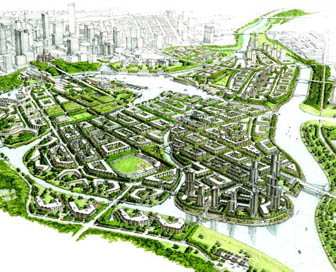




 |
Trinity River Central City Project
“When the Trinity River Vision is realized in 10 to 15 years, it will dramatically alter central Ft. Worth. Now the industrial area targeted for urban redevelopment floods every couple of years. Protecting the oxbow with the channel and flood control gates changes the game. All aspects of the project are incredibly complex, from the community engagement to the hydraulic engineering. Contributing to this project through the value engineering effort has been an honor.”
Steven Paget, CVS facilitator, LEED BD&C Associate, OAC Services, Inc. |
The VisionThe Trinity River Vision is big, bold and encompasses a master plan for urban revitalization, river restoration, flood control, and recreation covering 88 miles of the river and tributaries. Plan elements include the Fort Worth Central City project with flood control, channels and locks, bridges, and river restoration; the Trinity Uptown 800-acre mixed-use redevelopment with infrastructure, waterfront, and an urban lake; and the Gateway Park Improvement Plan, including improved access, ecosystem restoration, and recreation improvements. The anticipated overall investment exceeds $1 billion.
The RealityThe AFS|OAC joint venture partnership was engaged through our IDIQ contract with the U.S. Army Corps of Engineers (USACE) for value engineering (VE) services on the Fort Worth Central City portion of the project. USACE has partnered with the Trinity River Vision Authority and its multiple community stakeholders to deliver the project. The projected overall cost for the Central City portion of the project has been estimated at $673 million. We conducted the first phase VE study in 2010 focused on improvements valued at approximately $200 million. The improvements included an 8,400 ft. long bypass channel with a soft levee edge and a hard urban interface edge of walls, terraces, ramps and stairs, an interior water feature/urban lake surrounding the Trinity Uptown area, recreational access, flood control gates at the West Fork and Clear Fork of the Trinity River, 4,680 acre ft. of replacement valley flood water storage, and ecosystem restoration.
The project delivery team charged us with reviewing the design represented in the Final Environmental Impact Statement (FEIS) and Supplement No. 1 with a fresh perspective, validating the outcome of the multi-party planning process, and identifying opportunities for improving project quality, construction sequencing and logistics, and cost.
The Challenges
The OutcomeThe VE team picked through over 5,000 pages of collective project documentation, with a focus on the FEIS and supplement. We concluded that, overall:
Additionally, several key value improvements were recommended. Our use of a function analysis logic model (FAST model) helped reveal that restricting river flow would be a more cost effective means of increasing valley storage for flood water than the baseline design approach of excavating storage. The resulting alternative proposed a weir dam at a naturally low area for a projected savings of $6.5 million. Two alternatives were recommended to address the need for earthen levee protection. One involved the use of articulated mats and the other on the use of the native rock, adding $24 million and $20 million respectively to project cost. Each alternative offered just under $9 million in life cycle savings over a 25 year period for a reduction in channel maintenance.
The team analyzed the challenges and options regarding project delivery and recommended consideration of a Multiple Award Task Order Contract (MATOC) for construction of the bypass channel. Early selection of a pre-qualified contractor to assess construction challenges and propose design and logistical solutions could help reduce project risk and cost. Several alternatives were posed to enhance the architectural design and user-friendliness of the urban river access including a widened river walk to articulation of the channel walls to the use of native stone in lieu of cast concrete. The project team continues to refine the design and vet the project approach with the many community and funding stakeholders. AFS|OAC looks forward to completing the next phase VE study of the Trinity River Vision.
|